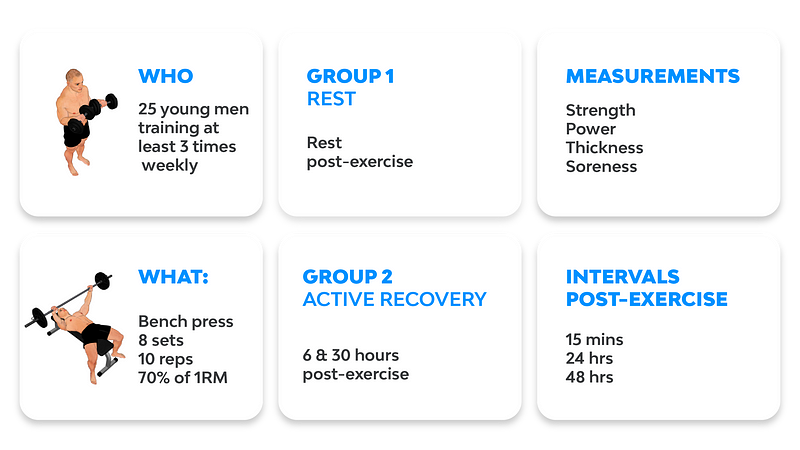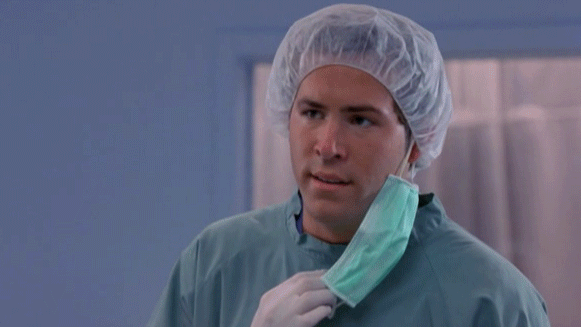How To Conquer Muscle Soreness And Muscle Pain Effectively
It would be a bad idea to train the same muscle group today, right? Well: not so fast. New research has surfaced findings that light training of the damaged muscle group can help with recovery better than merely resting. But just how light is ‘light’?

So — you’re still beat up and extremely sore from yesterday’s intense gym session.
It would be a bad idea to train the same muscle group today, right? Well: not so fast. New research has surfaced findings that light training of the damaged muscle group can help with recovery better than merely resting.
But just how light is ‘light’? Let’s examine the study.
Research
The researchers were interested in finding out if training the fatigued muscle group in the days following a damaging training session can improve recovery rates in comparison to taking the day off.
Subjects
For the purpose of the study, 25 young men with several years of lifting experience were rounded up. These men have an average training frequency of at least three times per week.
Protocol

Researchers had the 25 trained men perform 8 sets of 10 repetitions at 70% of their 1 RM (One Rep Max) on the bench press. Once that was done, the men were measured on four indices of recovery:
Strength
Power
Muscle thickness
Soreness
These measurements were taken at 15 minutes, 24 hours, and 48 hours post-exercise. To find out if light training helps with recovery, the investigators randomly assigned the men to two groups:
· Group 1 — consisted of 11 men who simply rested between the training session and the recovery test periods.
· Group 2 — the remaining 14 men performed active recovery at 6 and 30 hours post-exercise.
And in case you’re wondering, the active recovery consisted of 6 sets of 10 on the bench press at 10% of 1RM.
Findings
It seemed that the performance of light bench presses within the first two days after an intensive session provided quicker recovery in two measures: power and chest swelling. Other indices of recovery did not show significant differences between the two groups.
Interpretation
What do you do for recovery when you’re sore? If you’re like most people, you will opt for foam rolling, walking, low-intensity cycling, massage, cold water immersion, or maybe even cryotherapy if you’re feeling fancy and loaded.
But do you know why these methods work?

Well, they all achieve a single goal: to increase blood flow to the damaged muscle, while not causing any additional muscle damage.
And when you think about this basic premise behind muscle recovery, the study’s finding is unsurprising.
Here’s why. Obviously, when you train the same, sore muscle group at only 10% of your 1RM, you’re only increasing blood flow to the area. And because of the light load, you’re certainly not causing any additional tears and damage.
If you have been following our previous articles you’ve probably realised by now that light training is part of the deload week in the periodizationprogramme. But don’t worry if you have no idea what that is, because you too can train like elite athletes who the programme was designed for. Just click here
So — is there any difference between light training for recovery versus any one of the more traditional recovery modes, as mentioned above? Well, no.
Why would anyone choose to put their body through the torture of training the same muscle group again when they’re still sore, then?
Let’s examine some of the limitations of traditional recovery methods:
· Foam rolling — the recovery benefits that it provides appear to be pretty small.
· Massage — there seem to be clear benefits associated with prompt post-exercise massages, but who can afford going for massages several times a week? Let’s face it: massages are a splurge for most of us, and paying for it on a regular basis can get expensive fast.
· Compression garments — these tight clothing can help with soreness, and may even provide performance benefits. But keeping them on for long periods of time can get uncomfortable — this is especially so in warmer climates.
· Cold water immersion — it appears that there may be recovery benefits associated with this method, but it’s impractical for most. Also, if you’re someone who loves ending a workout with a cold soak, you might want to reconsider. Cold water immersion can negatively affect your muscle growth potential in the long-term.
· Cryotherapy — I’m not sure about you, but $70 — $300 per session sounds pretty expensive to me. This is probably an unsustainable recovery method for most, no matter the benefits it provides.
Applications and takeaways
Okay, so what does that mean for you? Should you only use light training for recovery? Definitely not.
Current research on light training for recovery has yet to produce impressive results. So don’t go limiting yourself to only one recovery method just yet. Instead, you need to understand that no single recovery method is both remarkable and practical at the same time.
And despite the relatively small benefit of light training (only swelling of the chest, isometric strength, and power production recovered more quickly), you should consider just how practical this method is.
With minimal effort required and no additional cost involved, there is little reason not to give light training a shot. Just consider this: to perform any exercise for a few sets of 10 at only 10% of 1RM is trivial for most of us — all you really need is a few extra minutes in the gym.
So: should you train while sore?
Yes, light training for recovery is definitely worth a try the next time you’re sore, so long as you are not so fatigued that even light exercise would risk injury. And of course, you’re the best judge of that, so always listen to your body.
Frustrated that you’ll have to do all the calculations for your light training recovery days?
Well, no worries: easily keep track of all the weights you should use through your tracked progress in GymStreak’s app. The clean and easy-to-use interface ensures that you’ll never have to flip through pages of hastily-scribbled gym notes just to find your bench press weights.
Talk about convenience!
What are you waiting for? Download GymStreak today to get your individualized workout plan!

References
Bartolomei, S., Totti, V., Griggio, F., Malerba, C., Ciacci, S., Semprini, G., & Di Michele, R. (2019). Upper-Body Resistance Exercise Reduces Time to Recover After a High-Volume Bench Press Protocol in Resistance-Trained Men. Journal of Strength and Conditioning Research. https://doi.org/10.1519/JSC.0000000000002960
Brown, F., Gissane, C., Howatson, G., van Someren, K., Pedlar, C., & Hill, J. (2017). Compression Garments and Recovery from Exercise: A Meta-Analysis. Sports Medicine (Auckland, N.Z.), 47(11), 2245–2267. https://doi.org/10.1007/s40279-017-0728-9
D’Amico, A. P., & Gillis, J. (2017). The influence of foam rolling on recovery from exercise-induced muscle damage. Journal of Strength and Conditioning Research. https://doi.org/10.1519/JSC.0000000000002240
Dupuy, O., Douzi, W., Theurot, D., Bosquet, L., & Dugué, B. (2018). An Evidence-Based Approach for Choosing Post-exercise Recovery Techniques to Reduce Markers of Muscle Damage, Soreness, Fatigue, and Inflammation: A Systematic Review With Meta-Analysis. Frontiers in Physiology, 9. https://doi.org/10.3389/fphys.2018.00403
Roberts, L. A., Raastad, T., Markworth, J. F., Figueiredo, V. C., Egner, I. M., Shield, A., … Peake, J. M. (2015). Post-exercise cold water immersion attenuates acute anabolic signalling and long-term adaptations in muscle to strength training. The Journal of Physiology, 593(18), 4285–4301. https://doi.org/10.1113/JP270570
